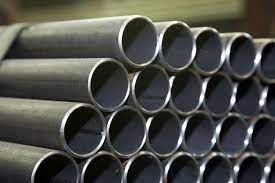2024-05-22 Back to list
The difference between seamless pipe and carbon steel pipe
Steel pipes play an important role in modern industry, especially in the oil, gas, chemical and construction fields. The two most common steel pipes are seamless steel pipes and carbon steel pipes. Although they are both made of steel, there are some distinct differences in their respective properties and uses. This article will focus on the differences between seamless steel pipes and carbon steel pipes.
First of all, from the perspective of production technology, seamless steel pipes are named after their manufacturing process. They are made through a hot-rolling process of seamless pipe walls. In contrast, the production process of carbon steel pipes includes cold drawing, cold rolling, and combustion steelmaking. Since the manufacturing process of seamless steel pipes is complex and costly, its market price is also relatively high. Carbon steel pipes, on the other hand, have relatively simple manufacturing processes and low production costs, so the price is also relatively low.

Secondly, from the perspective of physical properties, seamless steel pipes have higher strength and hardness. This is due to the heating and cooling processes during its manufacturing that result in grain refinement and lattice rearrangement of the steel. In addition, because of its seamless wall, seamless steel pipes have good quality on both the inner and outer surfaces and are less prone to cracks, defects and other problems. In contrast, although carbon steel pipes have lower strength and hardness, they have better toughness and ductility, making them more suitable for use in some high-temperature and high-pressure environments.
In addition, from the perspective of use, seamless steel pipes are mainly used in fields that require high strength and pressure resistance, such as oil and gas transportation, petrochemical industry, and mechanical structures. Because of its smooth inner and outer surfaces and low friction resistance, it is suitable for transporting liquids and gases. Carbon steel pipes are mainly used in hydraulic pipes, rainwater pipes, hot water pipes, etc. in the construction field. Carbon steel pipes are widely used in some ordinary buildings because of their low price.
Finally, from the chemical composition point of view, the chemical composition of seamless pipes is carbon C: 0.1~0.25%, silicon Si: 0.5~0.80, manganese Mn: 0.10~1.40, sulfur S: allowed to contain ≤0.035%, phosphorus P: allowed to be contained ≤0.035%, chromium Cr: 0.80~1.10, molybdenum Mo: 1.25~2.50, vanadium V: 0.07~1.2, copper Cu: allowed to contain ≤0.30%. Carbon steel is an iron-carbon alloy with a carbon content of 0.0218%-2.11%. It is also known as carbon steel. Generally also contains small amounts of silicon, manganese, sulfur, and phosphorus. Generally, the higher the carbon content in carbon steel, the greater the hardness and strength, but the lower the plasticity. Because no other alloying elements are added, it is more susceptible to oxidation and rust. The higher the carbon steel content, the greater the hardness and strength. Relatively speaking, the plasticity will be lower, and the price will be lower. Carbon steel can be divided into low carbon steel, medium carbon steel and high carbon steel according to carbon content.
To sum up, there are some obvious differences between seamless steel pipes and carbon steel pipes in terms of manufacturing process, physical properties ,uses and chemical composition. Whether you choose seamless steel pipes or carbon steel pipes, you should decide which pipe material to use based on specific needs to ensure a balance between project quality and cost performance.
-
DOM vs ERW: Which Is Stronger And What’s The Difference?
NewsJun.25,2024
-
ERW Pipe Specifications and Models
NewsMay.23,2024
-
ERW PRECISION TUBE
NewsJul.13,2024
-
WHAT IS ERW STEEL TUBE?
NewsMay.23,2024
-
WELDED STEEL PIPES DEMYSTIFIED: EXPERT BUYER’S INSIGHTS
NewsMay.23,2024
-
Classification of welded pipe
NewsMay.23,2024
 info@hbhuayang.com
info@hbhuayang.com
 +86-317-5296685
+86-317-5296685
